Tuesday, July 27, 2010
Guys in Austin with Yarn
As an adjunct to this effort, we started a group in Ravelry, Guys in Austin with Yarn (get it?) Please feel free to join -- being careful not to twist! And if you know of anyone who might be interested, pass the word along.
I now open up the floor to mockery of my lame photo manipulation skillz:
Saturday, July 24, 2010
Two Steeks Well Done, One Medium
I really ought to work on something else so that you can read about something besides this same garment post after post. But I’m all about sharin’ the love.
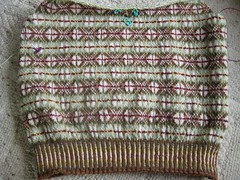 I’m still enjoying working on this, which is the real reason nothing has distracted me. I was a little tempted by the Tamarix Quilt featured in the latest Interweave Knits magazine to land on my doorstep – I want to knit it for Jeff’s cousin who is expecting at the end of the year – but I really don’t want this vest to languish. So I queued Tamarix up in Ravelry, and got back to the vest.
I’m still enjoying working on this, which is the real reason nothing has distracted me. I was a little tempted by the Tamarix Quilt featured in the latest Interweave Knits magazine to land on my doorstep – I want to knit it for Jeff’s cousin who is expecting at the end of the year – but I really don’t want this vest to languish. So I queued Tamarix up in Ravelry, and got back to the vest.
I’m at the steeks now, which is exciting. There are three. One at the beginning of the round for the left arm, one at the front for the v-neck opening, and one for the right arm. The latter two are the ones that are well done. It’s the steek that occurs at the beginning and end of the round that’s giving me fits. Because it’s at the beginning of the round, it’s where the colors change – right in the middle of the 12-stitch steek. So things are a bit loosey-goosey. It doesn’t make sense to weave the colors in as I was doing earlier with the color changes, since this section will be cut. I’ve tried tying the new color to the old with a square knot, but more often than (k)not, the knot is pulling through the first stitch of the round. It started out okay, but it’s getting rapidly uglier. I, uh, didn’t take a picture of that steek.
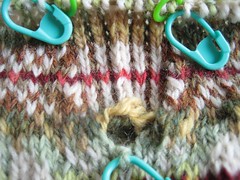 The next round I’m going to try just adding the new color, doing a bit of knitting, and then coming back to knot later. That way I can get the tension right before knotting. I probably shouldn’t be fretting about a section that’s going to be cut anyway, but since I plan to trust the physics of wool fiber rather than crocheting or sewing to reinforce the steek before cutting, I want things as neat and tidy as possible.
The next round I’m going to try just adding the new color, doing a bit of knitting, and then coming back to knot later. That way I can get the tension right before knotting. I probably shouldn’t be fretting about a section that’s going to be cut anyway, but since I plan to trust the physics of wool fiber rather than crocheting or sewing to reinforce the steek before cutting, I want things as neat and tidy as possible.
An interesting note that Ann Feitelson makes about the decreases: she instructs the knitter to always slant them toward the steek (or “extra stitches” as she calls them) rather than toward the knitted fabric. I’ve always done the opposite with decreases around neck and armholes in sweaters, and she notes that most American knitters do this. Feitelson points out that slanting toward the fabric actually exaggerates the edge of the fabric. Having followed her instructions, I can see her point. Clicking on the picture above will take you to the Flickr photo with notes showing which kinds of decreases I’m doing on each side of the steek.
I’m somewhere near row 100 of the 160 rounds I get to knit before shaping the neck. Over halfway there! The decreases are getting a bit strange and hard to track (at 4 places every 2 rounds 13 times and at 2 places every 3 rounds 21 times), but so far I’m keeping up.
Saturday, July 17, 2010
A Basenji of Interest
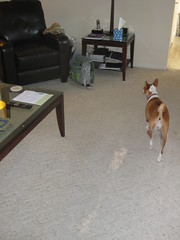 We had a little crime scene at our house this afternoon, and we’re pretty sure who the guilty party is.
We had a little crime scene at our house this afternoon, and we’re pretty sure who the guilty party is.
Every once in a while, Kate can’t resist plucking a ball of yarn from out of my knitting bag. She doesn’t dig in there, or anything – she just waits for me to leave it open. And then she carefully plucks it out and wreaks her havoc. I’ve caught her in the act a few times. But this is the most damage she’s done. Luckily, I overbought in the main accent color for the Vaila Slipover (Oyster Heather), so I don’t think we’re going to have much of a problem. There wasn’t much left in the ball. I have four balls left and I’m a third of the way through the project. So I think I’m good! Still, I hope I’ve learned a lesson about keeping the bag closed and putting my projects away after working on them.
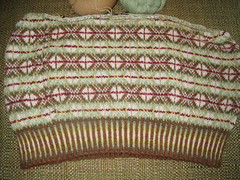 Progress on this project continues – not rapidly, but steadily. I’m 3/4 of the way through the third of four pattern repeats. Then it's ten more rows before starting the armhole decreases and the arm and neck steeks. When that happens, I’ll really feel like I’m getting someplace. I’m quite comfortable with the pattern at this point – it’s just finding the time to work on it. That, and having to take frequent breaks from having a wad of wool on my lap in 95-degree weather. Ugh. It’s definitely July in Texas.
Progress on this project continues – not rapidly, but steadily. I’m 3/4 of the way through the third of four pattern repeats. Then it's ten more rows before starting the armhole decreases and the arm and neck steeks. When that happens, I’ll really feel like I’m getting someplace. I’m quite comfortable with the pattern at this point – it’s just finding the time to work on it. That, and having to take frequent breaks from having a wad of wool on my lap in 95-degree weather. Ugh. It’s definitely July in Texas.
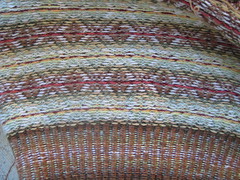 I decided to give the vest a haircut today – all the woven in ends were starting to drive me crazy. It was just a matter of moments to trim them all back. I left about 1/4 inch on each to give them a chance to felt into the back of the work with wear. That’s the idea, anyway. I’m still a bit freaked about having only a few inches of loosely woven-in yarn at the beginning and end of each round, but to date there have been no signs of unraveling. I’m going to trust that this yarn wants to to stay knit.
I decided to give the vest a haircut today – all the woven in ends were starting to drive me crazy. It was just a matter of moments to trim them all back. I left about 1/4 inch on each to give them a chance to felt into the back of the work with wear. That’s the idea, anyway. I’m still a bit freaked about having only a few inches of loosely woven-in yarn at the beginning and end of each round, but to date there have been no signs of unraveling. I’m going to trust that this yarn wants to to stay knit.
Back to it!
Thursday, July 08, 2010
Weaver & Weber
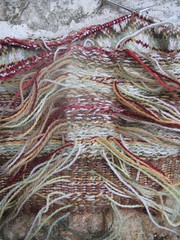 My ancestry includes my maternal grandmother, born with the surname Weaver, and a paternal great-grandmother with the surname Weber (German for Weaver). So perhaps my reluctance to knot the ends behind the work of my stranded knitting has an ancestral origin. Abbe asked if I was worried that Elizabeth Zimmerman would haunt me in my dreams –which may well have something to do with it. But for whatever reason, weave I will.
My ancestry includes my maternal grandmother, born with the surname Weaver, and a paternal great-grandmother with the surname Weber (German for Weaver). So perhaps my reluctance to knot the ends behind the work of my stranded knitting has an ancestral origin. Abbe asked if I was worried that Elizabeth Zimmerman would haunt me in my dreams –which may well have something to do with it. But for whatever reason, weave I will.
The process I discussed in the last post is working pretty well, and I’m getting faster at it. I’m not entirely consistent, but I try to start weaving in the new colors behind the working strands about 10 stitches before the round change. Then, I weave the ends of the old colors behind the strands of the new colors for 10 stitches or so into the new round. Most the time I switch from two colors to two different colors, but often I’m only changing the background color while keeping the oyster heather pattern color. And in a few rows, I get to work with the same two colors for two complete rounds -- my favorite.
 It’s amazing how grabby the yarn is. Probably not as sticky as actual Shetland wool, but it does work its way in rather quickly. After weaving in behind one stitch, it slips out at the slightest tug. But by the time the yarn has been woven in behind three stitches, it would probably break before coming unwoven. I’ve chosen to leave the ends hanging just for shock value, but in truth, all of the ends you see dangling in the first picture are ready to be trimmed. I’ll trim them eventually.
It’s amazing how grabby the yarn is. Probably not as sticky as actual Shetland wool, but it does work its way in rather quickly. After weaving in behind one stitch, it slips out at the slightest tug. But by the time the yarn has been woven in behind three stitches, it would probably break before coming unwoven. I’ve chosen to leave the ends hanging just for shock value, but in truth, all of the ends you see dangling in the first picture are ready to be trimmed. I’ll trim them eventually.
Progress is going faster than I thought it would. My two-fisted knitting is getting more coordinated. Things still look lumpy on the needle, but when I spread the fabric out, it looks pretty good. Unlike some projects, I’m really looking forward to the blocking on this one. I’m just shy of 2 full pattern repeats. At 4.5 repeats, I get to decrease for the sleeves and start the sleeve and neck steeks.
Saturday, July 03, 2010
Fair-to-Partly-Cloudy Isle
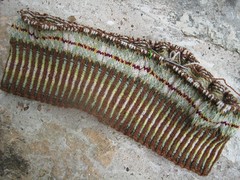 After second-guessing myself on gauge and monkeying around with needle sizes, I’ve decided to stick with the original size 3 needles called for in the pattern. Knitting loosely, I’m coming up with mostly 8 stitches per inch, and sometimes the specified 7.5. I’m gambling that I can make this work in the blocking. If not, I’m going to find someone slimmer than me to wear it , because at this point it’s more about the process than the final product.
After second-guessing myself on gauge and monkeying around with needle sizes, I’ve decided to stick with the original size 3 needles called for in the pattern. Knitting loosely, I’m coming up with mostly 8 stitches per inch, and sometimes the specified 7.5. I’m gambling that I can make this work in the blocking. If not, I’m going to find someone slimmer than me to wear it , because at this point it’s more about the process than the final product.
My tension is a little more uneven than it was on the swatch. I’m getting a bit more puckering around the diamond patterns, where several stitches in the same color occur. But I’m confident these will flatten out with the blocking.
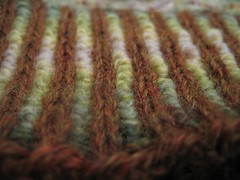 Right now, I’m experimenting with weaving in ends as I knit. I’ve seen several examples, including techniques at the TECHknitting website and at Knitting Daily. But while I understand how these would work while changing from one color to another, my brain hasn’t been capable of expanding these two changing from two colors to two other colors. So right now, I’m kind of going with a variation of the “3rd stitch” that’s described in the Philsopher’s Wool video for catching yarn behind the work. The trick that’s taken me a while to figure out is that you have to do this every other stitch, or it won’t work. I thought that doing it every stitch would be “better,” but it actually keeps the yarn from weaving in.
Right now, I’m experimenting with weaving in ends as I knit. I’ve seen several examples, including techniques at the TECHknitting website and at Knitting Daily. But while I understand how these would work while changing from one color to another, my brain hasn’t been capable of expanding these two changing from two colors to two other colors. So right now, I’m kind of going with a variation of the “3rd stitch” that’s described in the Philsopher’s Wool video for catching yarn behind the work. The trick that’s taken me a while to figure out is that you have to do this every other stitch, or it won’t work. I thought that doing it every stitch would be “better,” but it actually keeps the yarn from weaving in.
I’m not doing this for the main part of the vest, since I’m comfortable with 5-stitch floats (this maximum in this garment), but a variation of it seems to be working for introducing the new yarn 10 stitches before the round change and then also weaving in the old yarn for 10 stitches into the new round. It’s fiddly and really slows me down, but I think it’s working.
I’m also going a bit faster than I thought I’d be able to. Rather than constantly consulting the chart, I can usually break the 20 stitches of the pattern into multiples of 3, 5, or 7-stitch patterns that are pretty easy to memorize. About the time it becomes automatic, though, it’s time to change. I think that once I’ve gotten past the first 20 rounds of the pattern, I might not have to look at the chart much at all. Never a dull moment with this pattern, that’s for sure!

